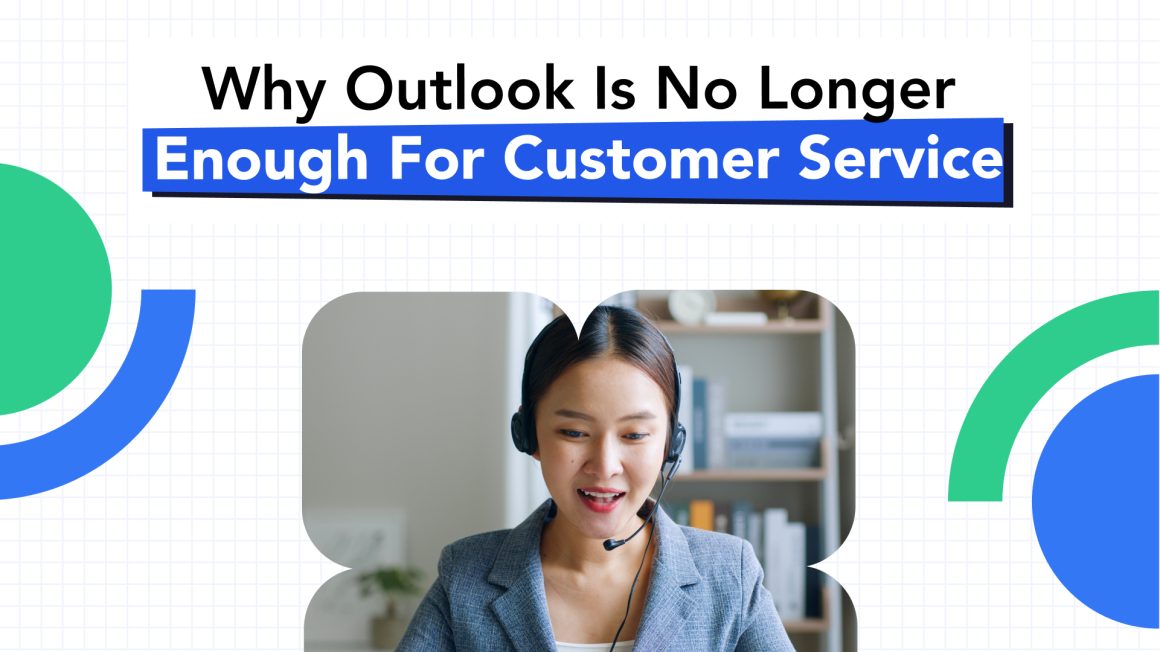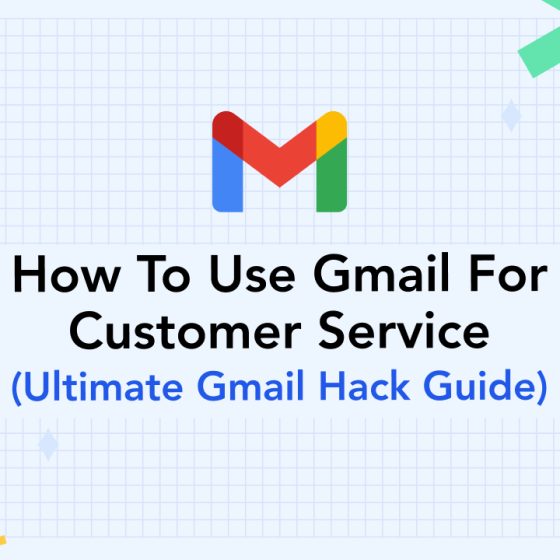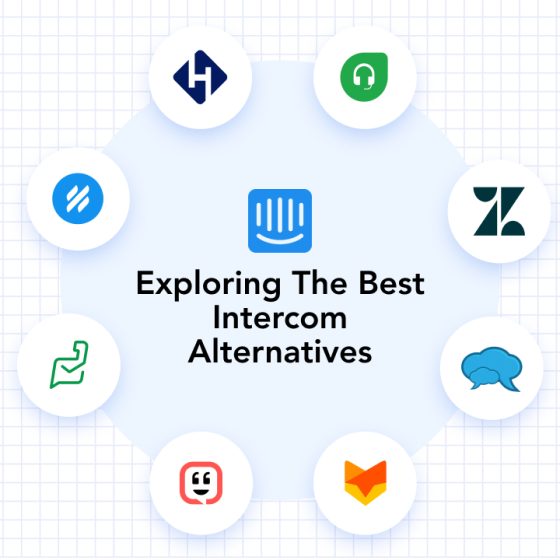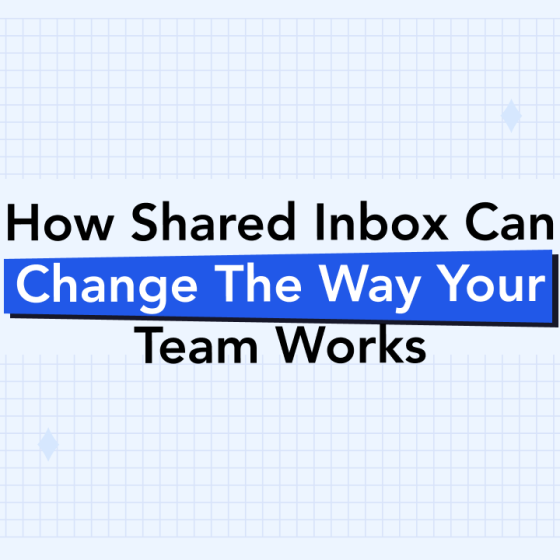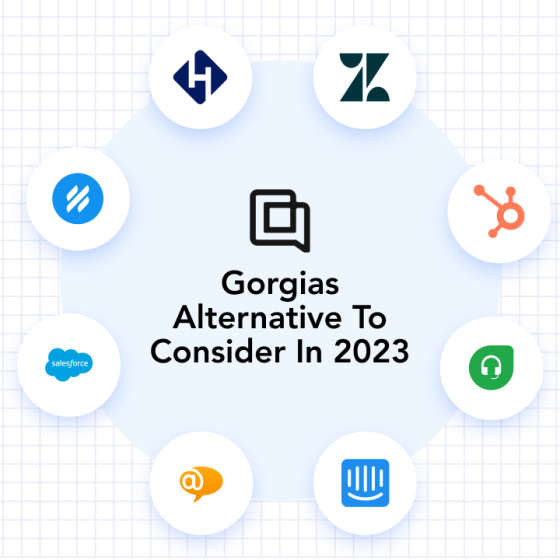Ah, Outlook. This email software has been a faithful companion to many of us for years. It’s like that old friend who’s always there for you, even if they’re not necessarily the best fit for every situation.
And when it comes to customer service, Outlook has undoubtedly been a go-to for many businesses.
But while familiarity is a great thing, it’s important to remember that sometimes we outgrow our old faithfuls. Just because something is comfortable doesn’t mean it’s the best option. Sticking with Outlook for customer service needs in 2023 might be akin to trying to ride a high-wheeler in a world of Teslas.
So, while we can certainly appreciate the comfort of familiarity and ease of use that comes with Outlook, it’s time to ask ourselves: Is it the best tool for the job? Or is it time to say goodbye and upgrade to a more modern solution?
This article gives you all the answers you’ll need. So, let’s dive right in.
Why is Outlook used for customer communication?
Before we say anything about Outlook, here are a few reasons why Outlook is still used for customer service:
01. Familiarity and Ease of Use
Let’s face it; Outlook is the OG email software. And with Outlook being one of the world’s most widely used email clients, it’s no wonder that so many customer service teams default to using it.
Plus, let’s not forget the comforting feeling of knowing exactly where everything is in Outlook. It’s like a well-worn leather jacket – you know where all the pockets are and which one holds your phone.
Similarly, Outlook users know where to find their emails, how to organize them, and how to send a quick reply.
02. Cost-Effective Option for Small Businesses
Money—the great equalizer. No matter the size of your business, budget is always a consideration. And when it comes to customer service, cost-effective options are a must.
Enter Outlook.
For small businesses, Outlook can seem like a godsend. It’s part of the Microsoft Office Suite, which many businesses already have, so there’s no additional cost to get started. And once you’re up and running, it’s a free way to communicate with your customers. Who doesn’t love free?
Plus, Outlook’s simple interface means you don’t need a ton of technical know-how to get started. And with the ability to set up rules and folders, you can keep your inbox organized and under control, even if you’re a one-person show.
03. Integration with other Microsoft Products
Another one of the reasons why Outlook has become so popular for customer communication is its integration with other Microsoft products.
If you’re already using Microsoft Office for your business, sticking with what you know is tempting. And when it comes to customer communication, Outlook’s seamless integration with other Microsoft products like Excel, Word, and PowerPoint can make life much easier.
Want to attach a spreadsheet to your email? No problem. Need to include a presentation for your customer? Easy peasy.
Outlook’s limitations for customer service
Familiarity is a great thing but it’s important to remember times are changing so we must change too. Just because something is comfortable doesn’t mean it’s the best option.
While we can appreciate the convenience of Outlook’s integration with other Microsoft products or the cost effectiveness, it’s important to ask ourselves: Are we sacrificing efficiency and effectiveness for the sake of sticking with what’s familiar? Or to save some money?
Is Outlook the best solution for our customer service needs?
If you are a business looking to improve your customer service and agent performance, it is certainly not—and here is why:
01. Lack of routing features
Without routing features, managing customer service requests can quickly become a game of whack-a-mole. The lack of advanced routing options in Outlook means that customer queries may not be directed to the appropriate team member or may get lost in a sea of other emails.
This can result in delayed response times, frustrated customers, and a decline in customer satisfaction.
Furthermore, without a proper routing mechanism, it can be challenging to determine which queries have been answered and which ones are pending. This lack of visibility can lead to a lack of accountability, making it difficult to identify performance issues and take corrective action.
02. No reporting and analytics
Imagine running a restaurant without any feedback from your diners. How would you know which dishes are a hit and which are a miss?
Without reporting and analytics, you might be in the dark about which customer issues are most common, which agents are performing well, and where there are opportunities to streamline processes and reduce response times.
Let’s not forget about the impact on agent performance. Without visibility into their performance metrics and areas for improvement, your agents might struggle to reach their full potential. It’s like trying to hit a bullseye without a target – you might get close, but you won’t know how to adjust your aim for a perfect shot.
03. No features for collaboration
Customer service isn’t a one-person job. It takes a team effort to provide top-notch support; collaboration is essential to making that happen. But with Outlook, collaboration is limited to forwarding emails and hoping for the best.
Without collaboration features, customer service agents are left to fend for themselves, leading to siloed communication and missed opportunities for learning and improvement. Without the ability to work together and share insights, agents are left to rely on their knowledge and experience.
Teamwork brings the dream work, but Outlook cannot do that for you.
04. Lack of multiple communication channels
When managing customer service across multiple communication channels like social media, WhatsApp, and live chat, Outlook might not be up to the mark. It might be like trying to juggle flaming torches while riding a unicycle – a recipe for disaster.
Customers these days expect to be able to reach businesses through various channels. Email is great, but sometimes you need to be able to handle a tweet or a WhatsApp message.
And that’s where Outlook falls short.
Without the ability to manage multiple communication channels, customer service agents might miss important messages or struggle to keep up with the volume of requests. Without a unified platform to manage all communication channels, agents might waste valuable time switching between different tools and interfaces.
Signs that Outlook isn’t meeting your customer service needs
Here are some common signs that it’s time to move away from Outlook and invest in a more robust customer service platform:
01. Rising customer complaints
Speaking of customer complaints, seeing an increase in negative feedback or unhappy customers could be a sign that Outlook isn’t cutting it. Customers expect quick and efficient support, and if your agents are struggling to keep up, it’s likely to show in customer satisfaction metrics.
02. Slow response times
Speaking of metrics, it might be time to reevaluate your customer service platform if your response times lag behind industry standards or your internal goals. Slow response times can lead to frustrated customers and negatively impact your brand reputation.
03. Overwhelmed and stressed customer service agents
If your customer service agents have become overwhelmed and stressed without valuable features and tools, it’s time to upgrade. Stressed agents only lead to high turnover rates and lower job satisfaction, which can be costly for your business.
04. Lack of visibility into customer service performance
You can’t track how your customer service looks? Or how your agents are performing? It’s time to make a switch from Outlook. Once you can track the customer service metrics, you’ll be able to take steps to improve the level of your customer service.
Top Outlook Alternatives for Customer Service in 2023
By now, you’re done with Outlook, aren’t you? Now you might want to explore the other options you have. While thousands of customer service software are in the market, we have made the job easier for you and picked the five best for you.
| Features/Software | Helpwise | Zendesk | HelpScout | Freshdesk |
| Email, SMS, Live Chat, Whatsapp | ✅ | ✅ | ✅ | ✅ |
| Native cloud phone system | ✅ | ✅ | ❎ | ✅ |
| AI features like paraphrase and summarize | ✅ | ✅ | ❎ | ❎ |
| Help Centers | ✅ | ✅ | ✅ | ✅ |
| Shared drafts | ✅ | ✅ | ❎ | ❎ |
| Auto-assignment (round robin etc) | ✅ | ✅ | ❎ | ✅ |
| Service reports and analytics | ✅ | ✅ | ✅ | ✅ |
01. Helpwise
Helpwise is a customer service solution which aims to unify customer experiences across multiple channels.
You can answer all customer queries across multiple channels from a single place—improving your productivity and helping in providing better customer service.
Pros:
- Pocket friendly option out of the lot.
- Super easy to set up and use
- Great customer support
Cons:
- Emails may appear in random orders.
Starts at US$12/user/month
- Omnichannel inboxes including Gmail, Outlook, Whatsapp, Instagram and SMS.
- Automation for tasks like assigning, tagging, closing and replying.
- Ability to set up Live chat and chatbots for your website
- Data-driven insights for improvement
Zendesk
Zendesk provides a complete solution to deliver customer service effortlessly. It provides a service as well as a sales solution. The software contains all basic and advanced features.
Pros:
- Powerful ticketing and routing features
- Customizable reporting and analytics
- Wide range of integrations
Cons:
- Can be expensive for small businesses
- Steep learning curve
Basic plans starting at US$19/month.
- Ability to offer omnichannel support
- Single unified agent workspace
- 1,000+ pre built integrations
- Self service options like built in help centers and communities.
- Analytics and reporting features like agent performance, customer retention rate.
Helpscout
Helpscout aims to provide a better way to talk to your customers by providing a solution that manages all customer communications in one powerful platform that feels just like your inbox.
Pros:
- Easy-to-use interface
- Collaboration features that allow teams to work together
Cons:
- Limited automation features
- Limited integrations with other platforms
Starts at US$20/user/month.
- Private notes, collision detection and assignment for smooth agent collaboration.
- Manual or automatic workflows to take care of repetitive tasks with simple if/then logic.
- Create inboxes for different teams
- Beacon bot for live chat
04. Freshdesk
Freshdesk is a feature-rich and user-friendly cloud-based customer support tool.
With a variety of support options, including live chat, email, phone, and social media, you can assist clients via their preferred channel of communication.
Pros:
- A free plan available
- Multiple ticket dispatching features
- Easy to set up and use
- 24×7 email support
Cons:
- No email and assist bot available in basic plans
- No ability to create custom metrics
Free for up to 10 users per month
- Advanced automation features such as workflows and canned responses
- Team huddle and private notes
- A customizable self-service portal for customers
To sum it all up
If you’re serious about delivering great customer service and improving efficiency, investing in a dedicated customer service platform is the way to go. From better ticketing and routing capabilities to powerful automation and reporting features, a dedicated platform can make a huge difference in the quality of your customer service.
So, don’t settle for Outlook as your only tool. Checkout Helpwise as the best alternative to Outlook.
Check out our next article on shared inbox solutions for guidance on choosing the best software to meet your business’s specific needs. Trust us, your customers (and your agents) will thank you for it.
